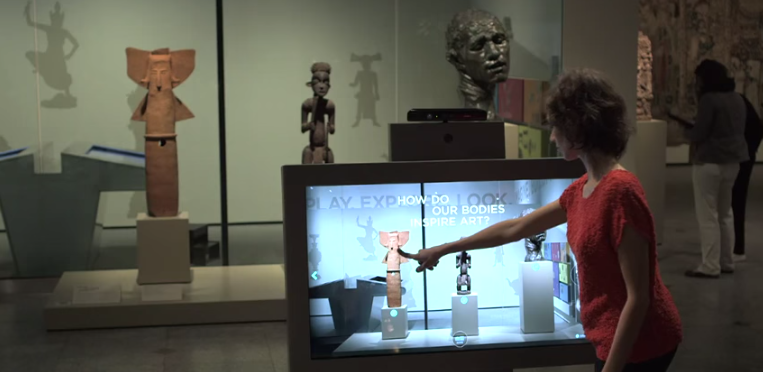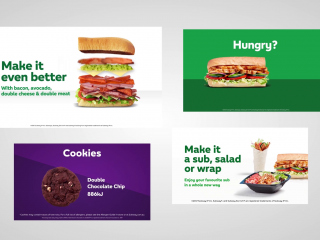Over the years, museums have transformed from being focused on passive viewing to immersing consumers in an interactive experience.
The development of digital technologies has allowed exhibitions to engage all of the senses, and encourage people to want to learn more about the history and knowledge of the world around them. There really are an endless number of solutions available, so below is a short summary of some cool and interesting ways museums and galleries can take advantage of the technology available to them.
1. PROJECTION MAPPING
Using projectors, light is mapped onto any surface turning common 3D objects into interactive displays.
Projection Mapping is an interesting and unique way to enhance an exhibition, as almost any surface can be transformed into a display. The wide range of projectors available on the market today also means a greater variety of room sizes and illumination levels can be used with Projection Mapping. Filling an entire room with projected images on just about every floor, wall and ceiling is possible by using special software to overlap and seamlessly connect multiple projectors.
Abstract shapes and sculptures can be projected on to, creating new and interesting canvases, like this installation at the National Maritime Museum in Greenwich. The segmented, geometric shapes allow dynamic new ways to display photos and videos, along with an engaging sounds-cape.
Alternatively, Projection Mapping can be used to help visitors visually build relationships between documents and artifacts within an exhibition. See this example at the Picasso Museum in Barcelona.
You can engage visitors even more by letting them contribute to an exhibition. An interactive projection display like this one at the United States Holocaust Memorial Museum allows visitors to leave a digital message in their own handwriting on a wall for future people to see.
2. TOUCHSCREENS
Commercial screens which allow physical interaction via the simple point of touch.
Touchscreens are more robust than consumer market products. Touchscreens add another element to your display by allowing the user to physically interact with the screen. Plus, they offer a more tangible and bright surface to display content within a museum. Combined with a traditional exhibit, you have the power to display an entire gallery of supporting images and documents that you wouldn’t normally be able to fit in the physical space.
Allow users to browse and find out more – Consumers can scroll through a timeline and see empires rise and fall or how plants develop and grow. The Cleveland Museum of Art has an amazing array of technology installations, from huge touchscreen video walls, to tablet PCs that visitors can carry around and engage with the exhibits to an even greater degree.
3. MULTITACTION SCREENS
Cutting edge interactive displays which offer advanced features over the standard touchscreens.
The next evolution in Touchscreens, Multitaction Screens have built-in infrared cameras and allow for unlimited points of touch, recognition of QR code markets directly through the screen, and seamless touch capability across any number of screens. An incredible addition to any Museum, Multitaction Screens promise to wow your audience. Check out the Multitaction wall at the Cleveland Museum of Art.
4. INTERACTIVE DESIGN
The creation of content that the user can control.
Whether it be via Projection Mapping, Touchscreens, Multitaction Screens or any other interactive devices, Interactive Design gives the consumer the engaging ability to control their own experience. You could include information visitors had just learned about the exhibit into a fun, casual gaming experience. Games could be simple touch screen games like you would find on a smartphone app, use Kinect motion capture to control the game, could even be more tactile with physical buttons and joysticks like an arcade game. The National Museum of Denmark have integrated a series of mini role-playing games, situated around an exhibition of the world longest, still existing Viking ship.
5. SITUATIONAL TECHNOLOGY
Used to truly enhance digital solutions on a case by case basis.
There is a range of different situational technologies available which are enhancing the interactivity of Projection Mapping, Touchscreens and Multitaction Screens even more. See here for the world’s largest video wall, which is driven by Kinect interactivity….
Below is a list of other technologies which can also enhance the consumer experience within a Museum.
Touch Film – Uses a film to turn any surface into a touch device. When mounted on a window, viewers can interact through the glass to a screen or projector behind.
Transparent LCD – Typically built in an enclosure, Transparent LCD’s allow a product or a historical document to be hidden and revealed using animated transparent content. This allows relevant information to appear around an artifact when a consumer approaches.
Leap Motion – Devices that track the users hands and all 10 fingers, to enable detailed gesture control for any application.
Kinects – A motion sensing input device which enables users to control and interact with a digital solution using gestures or full body movements.
The possibilities are endless.
There are limitless possibilities when it comes to implementing digital solutions into a Museum.
What Museums first need to do is consider what they most want to gain from implementing digital technology:
- More visitors to come and see the new technology?
- To offer more information with each exhibition?
- Engaging visitors for a longer period of time?
- Create a lasting impression, making visitors return for future exhibitions?
- All of the above?
Prendi works with clients to design and implement the perfect solution to fit their purpose, space and budget – big or small. Get in touch at contact@prendi.com.au





Leave a Reply